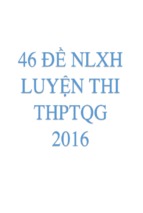MINISTRY OF EDUCATION AND TRAINING
HANOI NATIONAL UNIVERSITY OF EDUCATION
BUI HUY BACH
DATA ASSIMILATION PROBLEM
FOR SOME EVOLUTION EQUATIONS
IN FLUID MECHANICS
SUMMARY OF DOCTORAL THESIS IN
MATHEMATICS
Major: Differential and integral equations
Code: 9 46 01 03
HA NOI, 2020
This dissertation has been written at Hanoi National University of Education
Supervisor: Prof. Dr. Cung The Anh
Referee 1: Associate Professor Hoang Quoc Toan
Vietnam National University, Ha noi - University of Science
Referee 2: Associate Professor Doan Thai Son
Institute of Mathematics, Vietnam Academy of Science and
Technology
Referee 3: Associate Professor Do Duc Thuan
Hanoi University of Science and Technology
The thesis shall be defended at the University level Thesis Assessment Council at Hanoi National University of Education on . . . . . . . . .
This thesis can be found in:
- The National Library of Vietnam;
- HNUE Library Information Centre.
INTRODUCTION
1. Motivation and history of the problem
After studying the well-posedness of the problem, studying the data assimilation problem which is predicting future solutions from the observations, is
important because it allows us to understand and predict the development of
future systems. This is especially important in forecasting problems, such as
meteorological forecasting problems. Mathematically, this has given rise to a
new type of research, which has been strongly developing in recent years, called
the data assimilation problem. Suppose a complex process described by an
evolutionary equation takes the form
dY
= F (Y )
dt
where Y is a vector representing the state variable we want to ”forecast”. Our
goal is to find a ”good” approximation of Y over a time segment of length T .
We face the following problem: We don’t know the ”initial data” of Y at a time
before the time t0 to calculate the solution of the prediction model from the
moment t0 onwards, however, we know the ”measurement” of Y in the space
domain over time [t0 , T ] or at a time series {tn }n∈N . The data assimilation
problem is to determine a solution of approximately W (t) of Y (t) from known
”measurements”, such that W (t) converges to Y (t) (according to an appropriate
standard) when time t approaches infinity.
In recent years, the data assimilation problem, both continuous and discrete
cases, for two-dimensional Navier-Stokes system has been studied by E. Titi
et al. based on the existence of a finite global attractor and the determining
modes of the Navier-Stokes system (D.A. Jones and E.S. Titi (1993)), but the
disadvantage is that it is not applicable when the data is obtained in spatial
discrete form. Another effective approach applies to linear evolution systems
1
proposed by J.P. Puel in (J.P. Puel (2009)). but there are limitations that
only apply to linear problems. Please see (G.C. Garcı́a, A. Osses and J.P. Puel
(2011), O. Traore (2010)) on some recent results in this direction.
In 2014, Titi and colleagues proposed a new method (A. Azouani, E. Olson
and E.S. Titi (2014)) overcoming the disadvantages of the above methods. The
idea of this method is to use some feedback control class Ih (a feedback control
term) into the equation.
To study properties in general and data assimilation problems in particular of
the Navier-Stokes three-dimensional equation system, a common way is to study
on the α-model. Some results were available for the data assimilation problem
of α-models: Navier-Stokes-α model (D.A.F. Albanez, H.J. Nussenzveig-Lopes
and E.S. Titi (2016)), symplified Bardina model (D.A.F. Albanez and M.J.
Benvenutti (2018)),... and there are still many α-models that have not been
studied for both continuous data assimilation and discrete data assimilation.
A recent research direction, which is reducing the number of observations
down to less than the dimensions, is also attracting the attention of many scientists. The idea of reducing the number of dimensions observed from two
dimensions to one dimension and from three dimensions to two dimensions has
practical significance. The results of the reduction of observed data synchronization are only available for continuous cases and applied to the two-dimensional
Navier-Stokes system (A. Farhat, E. Lunasin and E.S. Titi (2016)) and threedimensional Leray-α model (A.Farhat, E. Lunasin and E.S. Titi (2017)). The
data assimilation problem continuously reduces the number of observations so
it is still an open problem for many other models. For the discrete case, how
to set up the discrete data assimilation algorithm to reduce the number of
observations and how to apply on the models is still an open question.
2. Overview of research issues
By using determining modes number, Titi et al. have studied the data assimilation problem for two-dimensional Navier-Stokes equations, in the case which
the data collected was continuous over a period of time (E. Olson and ES Titi
(2003)) and in the case which the data collected was discrete over time (K.
Hayden, E. Olson and E.S. Titi (2011)). But there is a disadvantage that it
2
does not apply when the data is obtained in a discrete space form, because it is
not possible to derive the derivative according to the spatial variables at those
discrete points.
In order to overcome the disadvantage, in 2014, Titi et al. proposed a new
method (A. Azouani, E. Olson and E.S. Titi (2014)). The idea of this method
is to use some feedback control term Ih (a feedback control term) included in
the equation. This practice is also known as Newtonian nudging or dynamic
relaxation (J. Hoke and R. Anthes (1976)). The Ih operator, under appropriate
conditions, has been shown to be a generalized operator, covering both the
operator used in the determination modes mentioned above, as well as the
operators used for determining nodes and volume elements (D.A.F. Albanez,
H.J. Nussenzveig-Lopes and E.S. Titi (2016)).
The content of the method is as follows: Assume that a system of equations
has the form
dY
= F (Y )
dt
(1)
(with known boundary conditions), unknown initial condition Y (t0 ) = Y0 . By
using the instrumentation, we know part of the solution over a period of time
[t0 , T ] (continuous data assimilation) or at times tn with n = 1, 2, ..., where ti ≤
tj , ∀i ≤ j and tn → ∞ when n → ∞ (discrete data assimilation). Because we
do not know the initial condition, we can not calculate Y (t). Therefore, instead
of counting Y (t), we find W (t), such that W (t) converges to Y (t) (according
to an appropriate standard) when the time t approaches infinity. Then, W (t)
is called an approximating solution, Y (t) is called a reference solution. The
symbol Ih (Y (t)) is the part of the solution we measured at the time t. Here, h
represents the coarseness of the measurement.
For the problem of continuous data assimilation, the measurement section
Ih (Y (t)) of the solution obtained over [t0 , T ], we consider the system of equations
dW
= F (W ) − µIh (W ) + µIh (Y )
dt
(2)
with the initial condition W (t0 ) = W0 we have guessed (get optional). Here,
the positive number µ is called the relaxation parameter. We will show that the
system (2) has a unique solution W (t) and that the value of the coarseness h is
small enough and the value of the relaxation parameter µ is large enough that
3
W (t) converges to Y (t) as time t approaches infinity. From a physical point of
view, the roughness of h is often difficult and expensive to change, while the
expansion parameter µ is a mathematical parameter that can easily be changed,
so we focus on finding the condition of h to exist for a value of µ ensures the
success of the algorithm.
For the problem of discrete assimilation, this is now closer to reality, as the
measurement of Ih (Y (t)) of the solution is obtained at discrete times tn with
n = 1, 2, ..., where ti ≤ tj , ∀i ≤ j and tn → ∞ when n → ∞ (discrete data
assimilation), replace for system (2), consider the following system of equations
∞
X
dW
= F (W ) − µ
Ih (W (tn ) − Y (tn ))χn
dt
n=0
(3)
with original conditions W (t0 ) = W0 as we anticipated (taking it as you like).
Call κ is maximum distance between two measurements:|tn+1 − tn | ≤ κ, ∀n ∈ N.
Just as for the (2), we prove that the system (3) has a unique solution W (t).
We then need to show that the coarseness h is small enough, the relaxation
parameter µ is large enough and the maximum distance between the measurements κ is small enough, so that W (t) converges to Y (t) when time t goes to
infinity.
In mathematics, the Navier-Stokes system of equations has a very important
role and attracts the attention of many scientists in the world. However, the
data assimilation method is only applicable to well posed models, which means
that the solution exists and is unique. For that reason, the results of data
assimilation are only available in two-dimensional Navier-Stokes equations (A.
Azouani, E. Olson and E.S. Titi (2014), C. Foias, C.F. Mondaini and E.S. Titi
(2016)). For the three-dimensional Navier-Stokes equations, we cannot prove
the same results. To study properties in general and data assimilation problems
in particular of the three-dimensional Navier-Stokes equation system, a common way is to study on α-models like Leray-α model (A. Cheskidov, D.D. Holm,
E. Olson and E.S. Titi (2005)), Navier-Stokes-α model (S. Chen, C. Foias, D.D.
Holm, E. Olson, E.S. Titi and S. Wynne (1998, 1999), C. Foias, D.D. Holm and
E.S. Titi (2001, 2002)), symplified Bardina model (Y. Cao, E.M. Lusanin and
E.S. Titi (2006), W. Layton and R. Lewandowski (2006)) and modified Leray-α
model (A. Cheskidov, D.D. Holm, E. Olson and E.S. Titi (2005), M.A. Hamed,
4
Y. Guo and E.S. Titi (2015)). Some results were available for the data assimilation problem given α-models: Navier-Stokes-α model (D.A.F. Albanez, H.J.
Nussenzveig-Lopes and E.S. Titi (2016)), symplified Bardina model (D.A.F.
Albanez and M.J. Benvenutti (2018)),...
Moreover, a new research direction, which is to reduce the number of observations down to a lower number of dimensions, is also attracting the attention
of many scientists. (A. Farhat, E. Lunasin and E.S. Titi (2016), A.Farhat, E.
Lunasin and E.S. Titi (2017)) and also an open problem for many other models.
3. Purpose, objects and scope of the thesis
• Purpose of the thesis: Research the data assimilation problem, both in
continuous and discrete cases, for some α-models in fluid mechanics.
• Objects of the thesis: Study the global unique existance and the asymptotic in time estimate of the difference between the solution of the data
assimilation problem (called the approximating solution) and the reference
solution (in the particular case of error-free measurements, we have convergence of the approximating solution toward the reference solution ), for
some α -model in fluid mechanics.
• Scope of the thesis:
– Content 1: Discrete data assimilation problem for the three-dimentional
Leray-α model:
∂v − ν∆v + (u · ∇)v + ∇p = f,
∂t
∇ · u = ∇ · v = 0,
– Content 2: Discrete data assimilation problem for the three-dimentional
Navier-Stokes-α model:
∂v − ν∆v − u × (∇ × v) + ∇p = f,
∂t
div u = 0,
– Content 3: Continuous data assimilation problem for the three-dimentional
simplified Bardina model utilizing measurements of only two compo5
nents of the velocity field:
∂v − ν∆v + (u · ∇)u + ∇p = f,
∂t
∇ · u = ∇ · v = 0,
– Content 4: Continuous data assimilation problem and discrete data
assimilation problem for the three-dimentional modified Leray-α utilizing measurements of only two components of the velocity field:
∂v − ν∆v + (v · ∇)u + ∇p = f,
∂t
∇ · u = ∇ · v = 0,
4. Research methods
• Studying discrete data assimilation problems: using the method in (C.
Foias, C.F. Mondaini and E.S. Titi (2016)) by E. Titi and colleagues.
• Studying continuous data assimilation problems: using the method in (A.
Azouani, E. Olson and E.S. Titi (2014), A. Farhat, E. Lunasin and E.S.
Titi (2016), A.Farhat, E. Lunasin and E.S. Titi (2019)) by E. Titi and
colleagues.
5. Results of thesis
• Proving the existence and uniqueness of the approximating solution, the
asymptotic in time estimate of the difference between the approximating
solution and the unknown reference solution, for the discrete data assimilation problem for the three-dimensional Leray-α model and the threedimensional Navier-Stokes-α model.
• Proving the existence and uniqueness of the approximating solution, the
convergence of the approximating solution to the unknown reference solution, for the abridged continuous data assimilation problem of the threedimensional symplified Bardinal model in both cases of interpolant operators of type I and type II.
6
• Proving the existence and uniqueness of the approximating solution, the
convergence of the approximating solution to the unknown reference solution, for both abridged discrete and continuous data assimilation problems with interpolant operators of type I of the three-dimensional modified
Leray-α model.
6. Structures of thesis
• Chapter 1. Preliminaries.
• Chapter 2. Discrete data assimilation for the three-dimentional Leray-α
model.
• Chapter 3. Discrete data assimilation for the three-dimentional NavierStokes-α model
• Chapter 4. Abridged continuous data assimilation for the three-dimentional
simplified Bardina model.
• Chapter 5. Abridged data assimilation for the three-dimentional modified
Leray-α.
7
Chapter 1
PRELIMINARIES
1.1. Some α-models
1.2. Interpolant operator Ih
1.3. Global attractor
1.4. Some function spaces
1.5. Some operators
1.6. Some useful inequalities
8
Chapter 2
DISCRETE DATA ASSIMILATION
ALGORITHM FOR THE
THREE-DIMENSIONAL LERAY-α
MODEL
2.1. Setting of the problem
Suppose that the evolution of u is governed by the three-dimensional Leray-α
model (A. Cheskidov, D.D. Holm, E. Olson and E.S. Titi (2005), A.Farhat,
E. Lunasin and E.S. Titi (2017)), subject to periodic boundary conditions on
Ω = [0, L]3 :
∂v − ν∆v + (u · ∇)v + ∇p = f,
∂t
(2.1)
∇ · u = ∇ · v = 0,
on the interval [t0 , ∞), where the initial data u(t0 ) = u0 is unknown.
In this context, we consider an increasing sequence of instants of time {tn }n∈N
in [t0 , ∞) at which measurements are taken. We assume that
tn < tn+1 , ∀n ∈ N v tn → ∞ khi n → ∞.
Moreover, we denote the maximum step size between successive measurements
by a positive constant κ, so that
|tn+1 − tn | ≤ κ, ∀n ∈ N.
We denote by ηn the error associated to the measurements at time tn . The
9
observational measurements at each time tn are thus represented by
ṽ(tn ) = Pm (v(tn )) + ηn ,
(2.2)
where v is the unknown reference solution of of the three-dimensional Leray-α
equations (2.1), Pm : H → span{w1 , . . . , wm } is the low Fourier modes pro-
jector, which is defined as the orthogonal projector of H onto the subspace
Hm = span{w1 , . . . , wm } generated by m first eigenfunctions of the Stokes op-
erator A, and ηn is the error associated to the measurements at time tn . We
assume that {ηn }n∈N is bounded in H.
Given an arbitrary initial data z0 ∈ V , we look for a function z satisfying
z(t0 ) = z0 , the same boundary conditions for v, and the following system
∞
P
∂z
−
ν∆z
+
(w
·
∇)z
+
∇q
=
f
−
µ
(Pm (z(tn )) − ṽ(tn )) ,
∂t
n=0
∇ · w = ∇ · z = 0,
z = w − α2 ∆w.
(2.3)
We can rewrite system (2.3) in the following equivalent form
∞
∞
P
P
dz + νAz + B(w, z) = Pf − µ
Pηn χn ,
P (Pm (z(tn ) − v(tn ))) χn + µ
dt
n=0
n=0
z = w + α2 Aw.
(2.4)
2.2. The existence and uniqueness and the convergence of
the approximating solution to the reference solution
We can rewrite system Leray-α in the following equivalent form
dv
+ νAv + B(u, v) = Pf,
dt
(2.5)
where v = u + α2 Au, and the initial condition v(0) = v0 ∈ H.
Theorem 2.1. (A. Cheskidov, D.D. Holm, E. Olson and E.S. Titi (2005)) Let
f ∈ H and v0 ∈ H. Then the system (2.5) has a unique global solution v that
satisfies
v ∈ C([t0 , ∞); H) ∩ L2loc (t0 , ∞; V ),
10
dv
∈ L2loc (t0 , ∞; V ′ ).
dt
(2.6)
Furthermore, the associated semigroup S(t) : H → H has a global attractor A
in H. Additionally, for any v ∈ A, we have
√
2νGr
,
(2.7)
|v| ≤ M0 :=
1/4
λ1
−3/4
where Gr = ν −2 λ1
|f | is the Grashoff number.
Theorem 2.2. Let z0 ∈ H, f ∈ H and let v be a trajectory in the global attractor
A of the 3D Leray-α model. Then, there exists a unique solution z of equation
(2.4) on [t0 , ∞) satisfying z(t0 ) = z0 and
z ∈ C([t0 , ∞); H) ∩ L2loc (t0 , ∞; V ),
dz
∈ L2loc (t0 , ∞; V ′ ).
dt
(2.8)
Let us set
BV (M0 ) := {v ∈ H : |v| ≤ M0 } .
Theorem 2.3. Let v be a trajectory in the global attractor A of the 3D Leray-α
model and let M0 be the positive constant related to estimates of the solution v
given in (2.7) below. Consider z0 ∈ BH (M0 ), and let z be the unique solution
of (2.4) on the interval [t0 , ∞) satisfying z(t0 ) = z0 . Assume that {ηn }n∈N is a
bounded sequence in H, namely, there exists a constant E0 ≥ 0 such that
|ηn | ≤ E0 , ∀n ∈ N.
(2.9)
If µ and m are large enough such that
25/2 c20 M02
µ≥
,
να3
8µ
,
λm+1 ≥
ν
and κ is small enough such that
�1/2
�
n
c
(νµ)1/2
νλ1
κ ≤ min 1, q
,
,
µ
µ
−1
2
2
2
−3
2
µ λ1 + c0 α (E0 + M0 )
o
νλ1 (2νλ1 + µ)
�
,
2 α−3 (E 2 + M 2 ) + µ2
µ ν 2 λ1 + µ2 λ−1
+
c
0
0
0
1
then
lim sup |z(t) − v(t)| ≤ cE0 .
t→∞
Moreover, if E0 = 0, then z(t) → v(t) in H, exponentially, as t → ∞.
11
(2.10)
(2.11)
(2.12)
Chapter 3
DISCRETE DATA ASSIMILATION
ALGORITHM FOR THE
THREE-DIMENSIONAL
NAVIER-STOKES-α MODEL
3.1. Setting of the problem
Suppose that the evolution of u is governed by the three-dimensional NavierStokes-α equations, subject to periodic boundary conditions on Ω = [0, L]3 :
∂ (u − α2 ∆u) − ν∆(u − α2 ∆u) − u × ∇ × (u − α2 ∆u)� + ∇p = f,
∂t
∇ · u = 0,
(3.1)
on the interval [t0 , ∞), where the initial datum u(t0 ) = u0 is unknown.
Given an arbitrary initial datum w0 ∈ V , we look for a function w satisfying
w(t0 ) = w0 , the same boundary conditions for u, and the following system
�
∂
2
2
2
(w
−
α
∆w)
−ν∆(w
−
α
∆w)
−
w
×
∇
×
(w
−
α
∆w)
+ ∇q
∂t
∞
P
(3.2)
= f − µ(I − α2 ∆)
(Pm w(tn ) − ũ(tn )) χn ,
n=0
∇ · w = 0.
we can rewrite system (3.2) in the following equivalent form
d
e
(w + α2 Aw) + νA(w + α2 Aw) + B(w,
w + α2 Aw)
dt
12
2
= Pf − µ(I + α A)
+ µ(I + α2 A)
∞
X
n=0
∞
X
n=0
P(Pm (w(tn ) − u(tn )))χn
(3.3)
Pηn χn .
3.2. The existence and uniqueness and the convergence of
the approximating solution to the reference solution
We can rewrite the three-dimensional Navier-Stokes-α equations in the following equivalent form
d
e u + α2 Au) = Pf
(u + α2 Au) + νA(u + α2 Au) + B(u,
dt
(3.4)
with the initial condition u(t0 ) = u0 ∈ V .
Theorem 3.1. Let f ∈ V ′ and u0 ∈ V . Then system (3.4) has a unique global
solution u such that u(t0 ) = u0 and
u ∈ C([t0 , ∞); V ) ∩ L2loc (t0 , ∞; D(A)),
du
∈ L2loc (t0 , ∞; H).
dt
(3.5)
Moreover, the semigroup S(t) : V → V generated by solutions of (3.4) has a
global attractor A in V , and we have
2
2
2
|u| + α kuk ≤ M0 :=
where Gr =
kf kV ′
3/4
ν 2 λ1
2Gr2 ν 2
1/2
λ1
,
∀u ∈ A,
(3.6)
is the Grashoff number in three dimensions.
Theorem 3.2. Let w0 ∈ V, f ∈ V ′ and let u be a trajectory in the global
attractor A of the 3D Navier-Stokes-α equations. Then, there exists a unique
solution w of the data assimilation equation (3.3) on [t0 , ∞) satisfying w(t0 ) =
w0 and
w ∈ C([t0 , ∞); V ) ∩ L2loc (t0 , ∞; D(A)),
Denote
dw
∈ L2loc (t0 , ∞; H).
dt
�
BV (M0 ) := u ∈ V : |u|2 + α2 kuk2 ≤ M0 .
13
(3.7)
Theorem 3.3. Let u be a trajectory in the global attractor A of the 3D NavierStokes-α equations and let M0 be the positive constant related to the estimate of
the solution u in (3.6) below. Consider w0 ∈ BV (M0 ), and let w be the unique
solution of (3.3) on the interval [t0 , ∞) satisfying w(t0 ) = w0 . Assume that
{ηn }n∈N is a bounded sequence in V , namely, there exists a constant E0 ≥ 0
such that
|ηn |2 + α2 kηn k2 ≤ E02 ,
∀n ∈ N.
(3.8)
If µ and m are large enough such that
�
�
2
c20 M0
2 c 0 M0
µ≥c
max λ1 , 2
,
να4
ν
λm+1 ≥
(3.9)
8µ
,
ν
(3.10)
and κ is small enough such that
� �1/2
� �1/2
ν
ν
, αν
,
µ
ψµ
o
α2 ν 2 (2νλ1 + µ)
�
� ,
2 )2 λ−1 + µ2 ν(λ−1 + α2 )2
µ ψ + µ2 (λ−1
+
α
1
1
1
n
c
αλ1
κ ≤ min 1,
µ
(1 + α2 λ1 )
where
�
2
ψ= ν +
then
−1/2
c20 λ1 α−2
M0 +
E02
��
−1/2
2
2
(λ−1
1 + α ) + c 0 λ1
�
lim sup |w(t) − u(t)|2 + α2 kw(t) − u(t)k2 ≤ cE02 .
M0 ,
t→∞
Moreover, if E0 = 0, then w(t) → u(t) in V , exponentially, as t → ∞.
14
(3.11)
Chapter 4
ABRIDGED CONTINUOUS DATA
ASSIMILATION FOR THE
SIMPLIFIED BARDINA MODEL
4.1. Setting of the problem
Suppose that the evolution of u is governed by the three-dimensional simplified
Bardina model, subject to periodic boundary conditions on Ω = [0, L]3 :
∂v − ν∆v + (u · ∇)u + ∇p = f,
∂t
∇ · u = ∇ · v = 0,
(4.1)
on the interval [t0 , ∞), where the initial data u(t0 ) = u0 is unknown.
Given an arbitrary initial datum u∗0 , we look for a function u∗ satisfying
u∗ (t0 ) = u∗0 , the same boundary conditions for u, and the following system
∂v3∗
∂v1∗
− ν∆v1∗ + u∗1 ∂x u∗1 + u∗2 ∂y u∗1 + u∗3 ∂z u∗1 + ∂x p∗
∂t
= f1 − µ (Ih (u∗1 ) − Ih (u1 )) ,
∂v2∗
− ν∆v2∗ + u∗1 ∂x u∗2 + u∗2 ∂y u∗2 + u∗3 ∂z u∗2 + ∂y p∗
∂t
= f2 − µ (Ih (u∗2 ) − Ih (u2 )) ,
(4.2a)
(4.2b)
− ν∆v3∗ + u∗1 ∂x u∗3 + u∗2 ∂y u∗3 + u∗3 ∂z u∗3 + ∂z p∗ = f3 ,
(4.2c)
∂x u∗1 + ∂y u∗2 + ∂z u∗3 = ∂x v1∗ + ∂y v2∗ + ∂z v3∗ = 0,
(4.2d)
v1∗ = u∗1 − α2 ∆u∗1 , v2∗ = u∗2 − α2 ∆u∗2 , v3∗ = u∗3 − α2 ∆u∗3 .
(4.2e)
∂t
We will consider interpolant observables given by linear interpolant operators
15
Ih : H 1 (Ω) → L2 (Ω), that approximate identity and satisfy the approximation
property
kϕ − Ih (ϕ)kL2 (Ω) ≤ γ0 hkϕkH 1 (Ω) ,
(4.3)
for every ϕ in the Sobolev space H 1 (Ω), or a second type of linear interpolant
operators Ih : H 2 (Ω) → L2 (Ω) that satisfy the approximation property
kϕ − Ih (ϕ)kL2 (Ω) ≤ γ1 hkϕkH 1 (Ω) + γ2 h2 kϕkH 2 (Ω) ,
(4.4)
for every ϕ in the Sobolev space H 2 (Ω). Moreover, from the enequality (4.3)
we have
|u − Ih (u)|2 ≤ c20 h2 kuk2 ,
(4.5)
for all u ∈ V , where c0 = γ0 , and from the enequality (4.4) we have
1
1
|u − Ih (u)|2 ≤ c20 h2 kuk2 + c40 h4 |Au|2 ,
2
4
(4.6)
for all u ∈ D(A), where c0 is only depend on γ0 , γ1 and γ2 .
4.2. The existence and uniqueness and the convergence of
the approximating solution to the reference solution
with observable data of type I
Theorem 4.1. Let f ∈ H. If u0 ∈ V then system (4.2) has a unique weak
solution u that satisfies u(t0 ) = u0 and
u ∈ C([t0 , ∞); V ) ∩ L2loc ([t0 , ∞); D(A)),
du
∈ L2loc ([t0 , ∞); H).
dt
Moreover, if u0 ∈ D(A) then system (4.2) has a unique strong solution u that
satisfies u(t0 ) = u0 and
u ∈ C([t0 , ∞); D(A)) ∩ L2loc ([t0 , ∞); D(A3/2 )),
du
∈ L2loc ([t0 , ∞); V ).
dt
Furthermore, the semigroup S(t) : V → V associated to (??), has a global
attractor A in V . Additionally, for any u ∈ A, we have
2
2
2
|u| + α kuk ≤
16
2ν 2 Gr2
1/2
λ1
,
(4.7)
and
kuk2 + α2 |Au|2 ≤
2ν 2 Gr2
1/2
λ1
�
λ1 νλ1 1
+ 2 +
2
α
ν
�
�
54c45 νGr4
exp
α 4 λ1
�
.
(4.8)
Theorem 4.2 ([Observable data of type I). Suppose Ih satisfies (4.3). Let u be
a solution in the global attractor of the 3D simplified Bardina model (4.1) and
choose µ > 0 large enough such that
�
� 4
�
�
cνGr2 λ1 νλ1 1
54c5 νGr4
µ≥
exp
,
+ 2 +
λ1 α 2
2
α
ν
α 4 λ1
(4.9)
and h > 0 small enough such that µc20 h2 ≤ ν.
If u∗0 ∈ V and f ∈ H, then there exists a unique weak solution u∗ of data
assimilation equation (4.2) on [t0 , ∞) satisfying u∗ (t0 ) = u∗0 and
∗
u ∈ C([t0 , ∞); V ) ∩
L2loc ([t0 , ∞); D(A)),
du∗
∈ L2loc ([t0 , ∞); H).
dt
Moreover, the solution u∗ depends continuously on the initial data u∗0 and it
satisfies
|u∗ (t) − u(t)|2 + α2 ku∗ (t) − u(t)k2 → 0,
at exponential rate, as t → ∞.
Theorem 4.3 (Observable data of type II). Suppose Ih satisfies (4.4). Let u
be a solution in the global attractor of the 3D simplified Bardina model (4.1)
and choose µ > 0 large enough such that (4.9) holds and h > 0 small enough
such that µc20 h2 ≤ 2ν and µc40 h4 ≤ 4να2 .
If u∗0 ∈ V and f ∈ H, then there exists a unique weak solution u∗ of equation
(4.2) on [t0 , ∞) satisfying u∗ (t0 ) = u∗0 and
∗
u ∈ C([t0 , ∞); V ) ∩
L2loc ([t0 , ∞); D(A)),
du∗
∈ L2loc ([t0 , ∞); H).
dt
Moreover, the solution u∗ depends continuously on the initial data u∗0 and it
satisfies
|u∗ (t) − u(t)|2 + α2 ku∗ (t) − u(t)k2 → 0,
at exponential rate, as t → ∞.
17
4.3. The existence and uniqueness and the convergence of
the approximating solution to the reference solution
with observable data of type II
Theorem 4.4. Suppose Ih satisfies (4.4). Let u be a solution in the global
attractor of the 3D simplified Bardina model (4.1) and choose µ > 0 large
enough such that
�
� 4
�
�
�
�
54c5 νGr4
cνGr6
cνGr2 λ1 νλ1 1
exp
+ 3 8 , νλ1 , (4.10)
+ 2 +
µ ≥ max
λ1 α 2
2
α
ν
α 4 λ1
λ1 α
and h > 0 small enough such that µc20 h2 ≤ ν and µc40 h4 ≤ 4να2 .
If u∗0 ∈ D(A) with
|u∗0 |2 + α2 ku∗0 k2 ≤
and
ku∗0 k2 + α2 |Au∗0 |2 ≤
2ν 2 Gr2
1/2
λ1
�
2ν 2 Gr2
1/2
λ1
λ1 νλ1 1
+ 2 +
2
α
ν
�
(4.11)
,
�
54c45 νGr4
exp
α 4 λ1
�
,
(4.12)
and f ∈ H, then there exists a unique strong solution u∗ of data assimilation
equation (4.2) on [t0 , ∞) satisfying u∗ (t0 ) = u∗0 and
∗
u ∈ C([t0 , ∞); D(A)) ∩
L2loc ([t0 , ∞); D(A3/2 )),
du∗
∈ L2loc ([t0 , ∞); V ),
dt
such that
ku∗ (t)k2 + α2 |Au∗ (t)|2 ≤
22ν 2 Gr2
1/2
λ1
+
�
λ1 νλ1 1
+ 2 +
2
α
ν
384000(16e + 2)c43 c44
ν 4 λ1 α 6
�
�
54c45 νGr4
exp
α 4 λ1
!3
2
2
2ν Gr
,
1/2
λ1
�
for all t > t0 . Moreover, the solution u∗ depends continuously on the initial
data u∗0 and it satisfies
ku∗ (t) − u(t)k2 + α2 |Au∗ (t) − Au(t)|2 → 0,
at exponential rate, as t → ∞.
18
- Xem thêm -




















